Rolex watches, private jets and third homes? Here’s what it takes to be in the world’s one per cent of wealth

What defines the global one percent? Rolex watches, luxury clothes, second (and third) homes, private jets, Lamborghinis… and millionaire-status, at least?
Well, yes. But more than that, too.
To become a part of the wealthiest band in developed countries, you need to have at least a net worth of £1m – and in some countries, assets of up to eight digits, data from Kinght Frank’s Wealth report finds.
In the UK, you need a net worth of over $3.1mn (£2.47) to join the one per cent – the eight highest amount of money in the world.
If you’re looking to move to high-finance enclave Monaco, by comparison, you’d need $12.9mn to join the financial elite.
Despite growth in high-value sectors, China is low on the ranking. Millionaire-status is around enough to accede to the club: you need only $1.1mn.
It’s worth noting purchasing power parity here, though – the average price in China cost 37,000RMB last year (£4,145) versus £285,000 in the UK at the same time.
In Monaco, the average house costs $5.5m.
Luxembourg closely follows Monaco at $10.8mn, with Switzerland up third place with a barrier to entry of $8.5mn.
This might be a little far off for the majority of the UK population, though: the median UK monthly wage was £2,334 in February (that’s the equivalent to an annual pre-tax salary of around £28,000 – an increase of 6.4 per cent vs February 2023), according to government data.
Londoners far slightly better – the median salary in the city is £40,000 for women and £48,000 for men, according to Plumpot.
Still, though, the top percentile of earners nationally brought in £199,000 before tax, falling to £130,000 after tax, according to the latest figures from the Office for National Statistics.
The top one percent of earners in the UK tend to be male, middle-aged and London-based, according to the IFS, with almost half of the top 0.1 per cent of income tax payers based in London.
That means a man aged 45–54 in London could be in the top one per cent nationally while still needing a further £550,000 to be in the top one per cent for his gender, age and region, according to the IFS.
Wealth inequality in developed countries is becoming increasingly stark: since 1990, inequality has increased in almost all developed nations, according to the UN.
Wealth inequality between the north and south of England is also set to grow, with the gap reaching £228,800 per head by 2030, according to IPPR annual State of the North report.
“It’s hard to avoid the conclusion that we are headed in the wrong direction on inequality in health, wealth, power, and opportunity while local government finances languish in chaos,” said the report author and IPPR North research fellow, Marcus Johns.

 Yahoo Finance
Yahoo Finance 